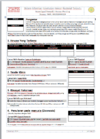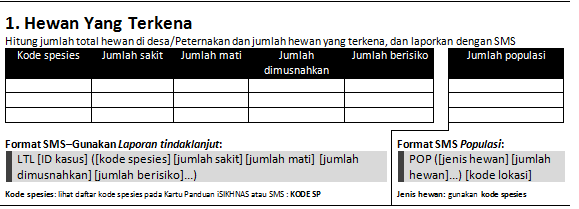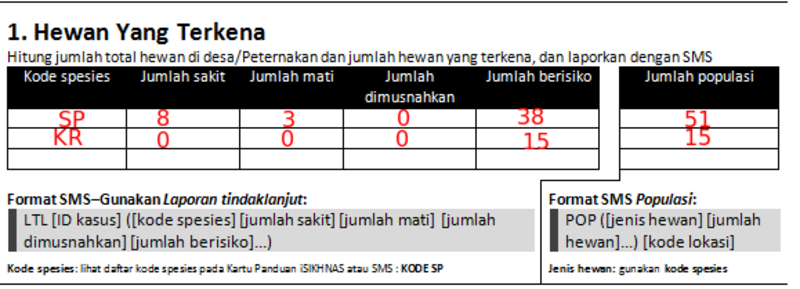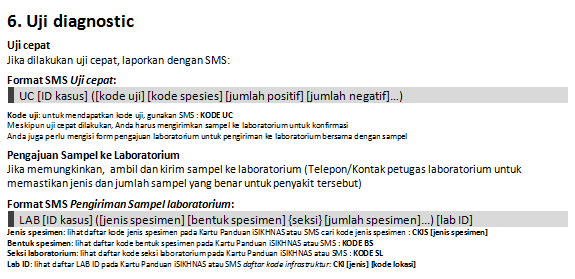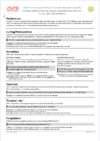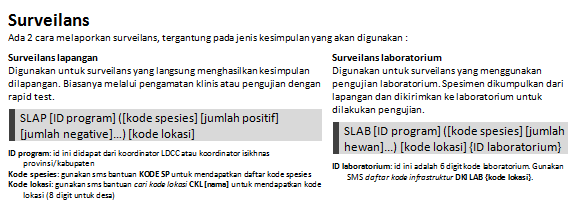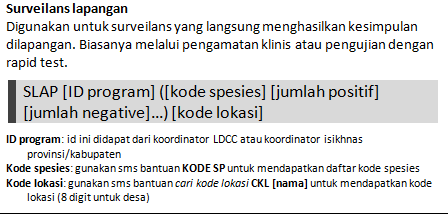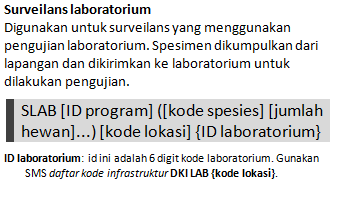Manuals:Priority disease investigation/id: Perbedaan revisi
(Updating to match new version of source page) |
(Created page with "Investigasi dan Respons Penyakit Penting") |
||
| Baris 1: | Baris 1: | ||
<languages/> | <languages/> | ||
| − | + | Investigasi dan Respons Penyakit Penting | |
===Introduction=== | ===Introduction=== | ||
| Baris 128: | Baris 128: | ||
[[File:PDI_form_id_kasus_dan_kode_lokasi 2.svg|800px|centre]] | [[File:PDI_form_id_kasus_dan_kode_lokasi 2.svg|800px|centre]] | ||
| − | '''ID Kasus''': | + | '''ID Kasus''': This was included in the original alert report from the Pelsa or paravet. If you don't know it, you can find it by using laporan desa |
| + | {{#apGetSMSFormat:lapd|1}} | ||
| − | '''Kode | + | '''Kode Lokasi''': To find the kode desa, use cari kode lokasi |
| + | {{#apGetSMSFormat:ckl|1}} | ||
===Hewan Yang Terkena=== | ===Hewan Yang Terkena=== | ||
| Baris 144: | Baris 146: | ||
Format SMS : Pakai '''Laporan tindak lanjut''': | Format SMS : Pakai '''Laporan tindak lanjut''': | ||
| − | + | {{#apGetSMSFormat:ltl|1}} | |
In the above example, the SMS would look like this... | In the above example, the SMS would look like this... | ||
| Baris 150: | Baris 152: | ||
LTL 14667 sp 8 3 0 38 kr 0 0 0 15 | LTL 14667 sp 8 3 0 38 kr 0 0 0 15 | ||
| − | '''Kode spesies''': | + | '''Kode spesies''': You can get a list of species codes by sending |
| + | KODE SP | ||
Report total populations by SMS | Report total populations by SMS | ||
| Baris 156: | Baris 159: | ||
Format SMS '''Populasi''': | Format SMS '''Populasi''': | ||
| − | + | {{#apGetSMSFormat:pop|1}} | |
In this example, the simplest SMS report of your recent population count would look like this... | In this example, the simplest SMS report of your recent population count would look like this... | ||
| Baris 164: | Baris 167: | ||
To be more thorough, you should differentiate the animal types within species by using the more detailed codes for animal types used in population reporting. | To be more thorough, you should differentiate the animal types within species by using the more detailed codes for animal types used in population reporting. | ||
| − | Jenis hewan: | + | '''Jenis hewan:''' Same as '''kode spesies'''. For more detail, look up codes using |
| + | KODE POP | ||
Remember: Look at the top of the page where you should have written ''Kode lokasi'' or look up codes using | Remember: Look at the top of the page where you should have written ''Kode lokasi'' or look up codes using | ||
| Baris 177: | Baris 181: | ||
Format SMS '''Tanda Klinis''': | Format SMS '''Tanda Klinis''': | ||
| − | + | {{#apGetSMSFormat:tk|1}} | |
| − | '''Kode tanda''': | + | '''Kode tanda''': To find the kode tanda use cari kode tanda |
| + | {{#apGetSMSFormat:ckt|1}}] | ||
===Riwayat Vaksinasi=== | ===Riwayat Vaksinasi=== | ||
| Baris 189: | Baris 194: | ||
Format SMS '''Riwayat Vaksinasi''': | Format SMS '''Riwayat Vaksinasi''': | ||
| − | + | {{#apGetSMSFormat:rvak|1}} | |
| − | '''Kode penyakit''': | + | '''Kode penyakit''': To find the kode tanda use cari kode penyakit |
| + | {{#apGetSMSFormat:ckp|1}} | ||
===Penularan pada manusia (Zoonosis)=== | ===Penularan pada manusia (Zoonosis)=== | ||
| Baris 201: | Baris 207: | ||
Format SMS '''Suspek Zoonosis''': | Format SMS '''Suspek Zoonosis''': | ||
| − | + | {{#apGetSMSFormat:z|1}} | |
Jika ada dugaan zoonosis tetapi tidak ada kasus pada manusia, laporkan dengan SMS | Jika ada dugaan zoonosis tetapi tidak ada kasus pada manusia, laporkan dengan SMS | ||
| − | + | Z [ID kasus] 0 0 0 | |
===Sumber penyakit=== | ===Sumber penyakit=== | ||
| Baris 215: | Baris 221: | ||
Format SMS '''Sumber penyakit''': | Format SMS '''Sumber penyakit''': | ||
| − | + | {{#apGetSMSFormat:sp|1}} | |
| − | + | You can check movement records using the '''laporan SKKH''' | |
| + | {{#apGetSMSFormat:lapsk|1}} | ||
| − | + | You can find the kode sumber using | |
| + | KODE SUM | ||
Jika penyakit tersebut diduga berasal dari lokasi lain yang diketahui, masukkan kode lokasi (tidak wajib) | Jika penyakit tersebut diduga berasal dari lokasi lain yang diketahui, masukkan kode lokasi (tidak wajib) | ||
| Baris 233: | Baris 241: | ||
Format SMS '''Uji cepat''': | Format SMS '''Uji cepat''': | ||
| − | + | {{#apGetSMSFormat:uc|1}} | |
| − | '''Kode uji''': | + | '''Kode uji''': to find the codes use |
| + | KODE UC | ||
Meskipun uji cepat dilakukan, Anda harus mengirimkan sampel ke laboratorium untuk konfirmasi | Meskipun uji cepat dilakukan, Anda harus mengirimkan sampel ke laboratorium untuk konfirmasi | ||
| Baris 246: | Baris 255: | ||
Format SMS '''Pengiriman Sampel laboratorium''': | Format SMS '''Pengiriman Sampel laboratorium''': | ||
| − | + | {{#apGetSMSFormat:lab|1}} | |
| − | '''Jenis spesimen''': | + | '''Jenis spesimen''': use |
| + | KODE JS | ||
| − | '''Bentuk | + | '''Bentuk specimen''': use |
| + | KODE BS | ||
| − | '''Seksi laboratorium''': | + | '''Seksi laboratorium''': use |
| + | KODE SE | ||
| − | '''Lab ID''': | + | '''Lab ID''': use cari kode infrastruktur |
| + | {{#apGetSMSFormat:cki|1}} | ||
===Pengajuan Sampel ke Laboratorium=== | ===Pengajuan Sampel ke Laboratorium=== | ||
| Baris 262: | Baris 275: | ||
Format SMS Pengiriman Sampel laboratorium: | Format SMS Pengiriman Sampel laboratorium: | ||
| − | + | {{#apGetSMSFormat:lab|1}} | |
| − | '''Jenis spesimen''': | + | '''Jenis spesimen''': use |
| + | KODE JS | ||
'''Bentuk specimen''': use | '''Bentuk specimen''': use | ||
| Baris 285: | Baris 299: | ||
Format SMS '''Diagnosa definitif''': | Format SMS '''Diagnosa definitif''': | ||
| − | + | {{#apGetSMSFormat:dx|1}} | |
| − | '''Kode penyakit''': cari kode penyakit | + | '''Kode penyakit''': use cari kode penyakit |
| + | {{#apGetSMSFormat:ckp|1}} | ||
Jika Tidak, dan Anda ingin memperbaiki diagnosa banding, laporkan dengan SMS: | Jika Tidak, dan Anda ingin memperbaiki diagnosa banding, laporkan dengan SMS: | ||
| Baris 293: | Baris 308: | ||
Format SMS – Gunakan '''Laporan Respons''': | Format SMS – Gunakan '''Laporan Respons''': | ||
| − | + | {{#apGetSMSFormat:r|1}} | |
| − | '''Kode penyakit''': cari kode penyakit | + | '''Kode penyakit''': use cari kode penyakit |
| + | {{#apGetSMSFormat:ckp|1}} | ||
====Penyakit prioritas tinggi==== | ====Penyakit prioritas tinggi==== | ||
| Baris 320: | Baris 336: | ||
Format SMS '''Laporan tindak lanjut''': | Format SMS '''Laporan tindak lanjut''': | ||
| − | + | {{#apGetSMSFormat:ltl|1}} | |
If No: | If No: | ||
| Baris 328: | Baris 344: | ||
Format SMS '''Laporan tindak lanjut''': | Format SMS '''Laporan tindak lanjut''': | ||
| − | + | {{#apGetSMSFormat:ltl|1}} | |
[[File:PDI_form_1_status_penyakit.png|800px|centre]] | [[File:PDI_form_1_status_penyakit.png|800px|centre]] | ||
| Baris 387: | Baris 403: | ||
Laporkan hewan yang sudah di culling/ di musnahkan dimana kegiatan pemusnahan tersebut merupakan bagian dari kegiatan respon penyakit hewan yang dilaksanakan. Laporan yang terpisah dikirimkan setiap hari untuk desa yang berbeda. | Laporkan hewan yang sudah di culling/ di musnahkan dimana kegiatan pemusnahan tersebut merupakan bagian dari kegiatan respon penyakit hewan yang dilaksanakan. Laporan yang terpisah dikirimkan setiap hari untuk desa yang berbeda. | ||
| − | + | {{#apGetSMSFormat:cul|1}} | |
| − | * | + | *ID program: get this from you LDCC or iSIKHNAS coordinator |
| − | * | + | *Kode spesies: to get a list of species code use |
| − | * | + | KODE SP |
| + | *Kode lokasi: use cari kode lokasi | ||
| + | {{#apGetSMSFormat:ckl|1}} | ||
====Surveilans==== | ====Surveilans==== | ||
| Baris 403: | Baris 421: | ||
[[File:PDI_form_2_SLAP.png|600px|centre]] | [[File:PDI_form_2_SLAP.png|600px|centre]] | ||
| − | + | This is used for surveillance that produces a result in the field. Normally this is either clinical surveillance or testing with a rapid test. | |
| − | + | {{#apGetSMSFormat:slap|1}} | |
| − | |||
| − | * | + | *ID program: get this from you LDCC or iSIKHNAS coordinator |
| − | * | + | *Spesies: to get a list of species code use |
| − | * | + | KODE SP |
| + | *Lokasi: use cari kode lokasi | ||
| + | {{#apGetSMSFormat:ckl|1}} | ||
=====Surveilans laboratorium===== | =====Surveilans laboratorium===== | ||
| Baris 417: | Baris 436: | ||
Digunakan untuk surveilans yang menggunakan pengujian laboratorium. Spesimen dikumpulkan dari lapangan dan dikirimkan ke laboratorium untuk dilakukan pengujian. | Digunakan untuk surveilans yang menggunakan pengujian laboratorium. Spesimen dikumpulkan dari lapangan dan dikirimkan ke laboratorium untuk dilakukan pengujian. | ||
| − | + | {{#apGetSMSFormat:slab|1}} | |
| − | * | + | *ID laboratorium: this is the 6 digit laboratory code. Gunakan daftar kode infrastruktur |
| + | DKI LAB {kode lokasi} | ||
====Vaksinasi==== | ====Vaksinasi==== | ||
| Baris 427: | Baris 447: | ||
SMS ini digunakan kegiatan vaksinasi yang sudah direncanakan dalam merespon wabah penyakit. Laporan yang terpisah dikirimkan setiap hari untuk desa yang berbeda. | SMS ini digunakan kegiatan vaksinasi yang sudah direncanakan dalam merespon wabah penyakit. Laporan yang terpisah dikirimkan setiap hari untuk desa yang berbeda. | ||
| − | + | {{#apGetSMSFormat:vak|1}} | |
* '''ID program''': id ini didapat dari koordinator LDCC atau koordinator isikhnas provinsi/kabupaten | * '''ID program''': id ini didapat dari koordinator LDCC atau koordinator isikhnas provinsi/kabupaten | ||
| Baris 437: | Baris 457: | ||
SMS ini digunakan untuk kegiatan-kegiatan lain seperti KIE, desinfeksi dan lain-lain. | SMS ini digunakan untuk kegiatan-kegiatan lain seperti KIE, desinfeksi dan lain-lain. | ||
| − | + | {{#apGetSMSFormat:tl|1}} | |
| − | * | + | *ID program: get this from you LDCC or iSIKHNAS coordinator |
| − | * | + | *Kode jenis tindaka: use |
| − | * | + | KODE TL |
| + | *Lokasi: use cari kode lokasi | ||
| + | {{#apGetSMSFormat:ckl|1}} | ||
====Pengobatan==== | ====Pengobatan==== | ||
| Baris 449: | Baris 471: | ||
Apabila dilakukan pengobatan pada hewan, laporkan dengan SMS berikut ini : | Apabila dilakukan pengobatan pada hewan, laporkan dengan SMS berikut ini : | ||
| − | + | {{#apGetSMSFormat:ob|1}} | |
| − | * | + | *ID kasus: get this from the original alert report, or use laporan desa |
| − | * | + | {{#apGetSMSFormat:lapd|1}} |
| + | *Kode obat: use cari kode obat | ||
| + | {{#apGetSMSFormat:cko|1}} | ||
Revisi per 17 September 2014 08.41
Investigasi dan Respons Penyakit Penting
Daftar isi
- 1 Introduction
- 2 Tools for use during an important disease investigation and response
- 3 Investigation
- 3.1 What data should be collected during an important disease investigation?
- 3.2 Formulir 1 - Investigasi Penyakit Hewan Penting
- 3.3 Hewan Yang Terkena
- 3.4 Tanda Klinis
- 3.5 Riwayat Vaksinasi
- 3.6 Penularan pada manusia (Zoonosis)
- 3.7 Sumber penyakit
- 3.8 Uji diagnostic
- 3.9 Pengajuan Sampel ke Laboratorium
- 3.10 Diagnosa
- 3.11 Tindak lanjut
- 4 Response
Introduction
iSIKHNAS handles both routine and priority disease reports (U and P) from the field. These are usually initiated by Pelsa (village reporters) or paravets doing routine case work. When a vet or paravet responds to a pelsa report they usually contact the pelsa to find out more about the case, visit if it seems important and respond to the system with a response report (R). The response report asks for a differential diagnosis from the attending staff member and it is here that a case is usually properly determined to be either important or routine. Routine case management might involve treatments, lab samples and an outcome report, for example. Important cases however require fuller investigation, may reach a definitive diagnosis and may require an outbreak response.
iSIKHNAS is able to be used for all the common activities involved in both routine cases as well as any field investigation of an important disease.
An important disease is;
- a disease on the national priority list,
- a disease with high mortality or morbidity,
- a disease with zoonotic involvement,
- a disease with unusual signs, or suspected of being a new or emerging disease.
The purpose of an investigation into an important disease is to determine a definitive diagnosis so that important diseases can be ruled in or out and so that our response to the disease event can be properly guided. Before the diagnosis, information is required to determine if a response is urgent (not waiting for diagnosis) and to gather information to help with designing a suitable response (assess the magnitude of the problem, and determine the epidemiology of the problem).
Tools for use during an important disease investigation and response
Disease investigation for important diseases can be complex and stressful. iSIKHNAS works in partnership with veterinary staff to ensure good communication, ease the reporting burden, provide outside assistance when necessary and streamline the investigation process. Disease investigation is greatly assisted by the use of worksheets (see above) which guide the investigation and response process and assist veterinary staff in the collection and reporting of investigation related data directly from the field.
- Formulir 1 & 2 are generic iSIKHNAS work guides to assist in any investigation and response for any disease including HPAI and Rabies.
These worksheets are intended as a notetaking tool, a place for calculations and as a procedural guide only - they are not intended to be kept as a permanent record nor are they intended as rules for conducting investigations and response. Data submitted via SMS to iSIKHNAS at every step of the investigation is linked to a case ID, incorporated into the database and immediately available for viewing, use and analysis by a wide range of users. No further data entry is required.
For information about the future integration of PDSR activities: PDSR Integration
Investigation
What data should be collected during an important disease investigation?
- Population
- How many animals in the village?
- How many affected (sick, dead, slaughtered, at risk)?
- What do they look like?
- Clinical signs
- Risk factors
- Have the sick animals been vaccinated for any diseases (helps with the differential)?
- Is it zoonotic?
- Human involvement
- Where did it come from?
- Source of the infection to take action there as well
- Tests
- Rapid test results or details of samples sent to the lab
- Diagnosis
- Definitive diagnosis (from field observations with or without evidence from tests)
- Monitoring and resolution
- Are control activities working? Is the problem continuing or resolved?
iSIKHNAS is able to collect, validate and manage all this information as it is being reported from the field, communicate it to others responsible and even get feedback from experts with access to the same data. iSIKHNAS was designed with a certain philosophy which believes that;
- Important disease investigations and response should be a normal responsibility for all dinas veterinarians
- Any vet trained in the basic use of iSIKHNAS SMS reporting should be able to report the results of an investigation and response
- Investigations and response reporting use the same tools (SMS messages) as used for routine case management, so users are familiar with them, even if important disease events are uncommon.
iSIKHNAS is also founded on the principle that all data capture tasks should provide much more benefit than costs to the user in the field. The important disease investigation service provided by iSIKHNAS eliminates paperwork, sends immediate notification to others that need to know and provides the opportunity for others to provide real-time support and expertise. The transparency of the process also builds confidence in the entire system at every level.
How iSIKHNAS collects this data
| Data collected in an investigation | iSIKHNAS SMS code |
|---|---|
| Population | |
| How many animals in the village? | POP |
| How many affected (sick, dead, slaughtered, at risk)? | LTL |
| Clinical signs | TK |
| Risk factors | |
| Have the sick animals been vaccinated for any diseases (helps with the differential)? | RVAK |
| Human involvement? | Z |
| Where did it come from? | SP |
| Recent livestock movements? | LAPSK |
| Tests | |
| Rapid test results | UC |
| Samples sent to the lab | LAB |
| Diagnosis | |
| Differential diagnosis | R |
| Definitive diagnosis (from field observations with or without evidence from tests) | DX |
| Monitoring and resolution | |
| Are control activities working? Is the problem continuing or resolved? | LTL |
Summary: Messages recommended for use in an important disease investigation
- LTL: Laporan Tindakan Langjut
- TK: Tanda Klinis
- RVAKː Riwayat Vaksinasi
- Zː Zoonosis
- SPː Sumbar Penyakit
- UC: Uji Cepat
- LAB: Pengajuan Sampel ke Laboratorium
- DX: Diagnosa Definitif
- R: Respons
Formulir 1 - Investigasi Penyakit Hewan Penting
Formulir ini digunakan sebagai panduan untuk Dokter Hewan selama melakukan investigasi penyakit penting : (Penyakit Prioritas Nasional, penyakit dengan mortalitas atau morbiditas yang tinggi, zoonosis, tanda klinis yang tidak biasa atau diduga penyakit baru atau penyakit yang baru muncul (emerging disease)). Semua data harus dikirim segera melalui SMS ke iSIKHNAS menggunakan format yang ada di formulir. Formulir ini adalah lembar kerja untuk membantu pengiriman SMS – jangan mengirimkan formulir ini.
In order to conduct a priority disease investigation, staff will need to be sure of the case ID and the location code of the locale where the case is situated prior to going to the field for the investigation. All SMS messages sent during any priority disease investigation will require the case ID which is automatically created by iSIKHNAS as soon as a U or a P disease report is sent from the field.
Note these down on the form to help you because you may need them for several messages connected with this investigation.
ID Kasus: This was included in the original alert report from the Pelsa or paravet. If you don't know it, you can find it by using laporan desa
LAPD [kode desa]
Kode Lokasi: To find the kode desa, use cari kode lokasi
CKL [nama lokasi]
Hewan Yang Terkena
Count the total number of animals in the village/farm, and the number of affected animals.
Hitung jumlah total hewan di desa/Peternakan dan jumlah hewan yang terkena, dan laporkan dengan SMS
Format SMS : Pakai Laporan tindak lanjut:
LTL [ID kasus] ([spesies] [jumlah sakit] [jumlah mati] [jumlah dimusnahkan/potong bersyarat] [jumlah berisiko]...) {selesai}
In the above example, the SMS would look like this...
LTL 14667 sp 8 3 0 38 kr 0 0 0 15
Kode spesies: You can get a list of species codes by sending
KODE SP
Report total populations by SMS
Format SMS Populasi:
POP ([jenis hewan] [jumlah hewan]...) {lokasi}
In this example, the simplest SMS report of your recent population count would look like this...
POP sp 51 kr 15 73060306
To be more thorough, you should differentiate the animal types within species by using the more detailed codes for animal types used in population reporting.
Jenis hewan: Same as kode spesies. For more detail, look up codes using
KODE POP
Remember: Look at the top of the page where you should have written Kode lokasi or look up codes using
CKL [nama lokasi]
Tanda Klinis
Amati tanda klinis yang muncul dan laporkan dengan SMS:
Format SMS Tanda Klinis:
TK [ID kasus] [tanda,tanda...]
Kode tanda: To find the kode tanda use cari kode tanda
CKT [tanda]]
Riwayat Vaksinasi
Riwayat vaksinasi terakhir hewan yang terkena sesuai dengan penyakit yang diinvestigasi. Jika Ya, laporkan dengan SMS:
Format SMS Riwayat Vaksinasi:
RVAK [ID kasus] ([kode penyakit] [tanggal vaksinasi]...)
Kode penyakit: To find the kode tanda use cari kode penyakit
CKP [penyakit]
Penularan pada manusia (Zoonosis)
Ask if there are any people that have been exposed, are sick, or have died of a disease that may be related to the animal disease (a possible zoonotic disease).
Format SMS Suspek Zoonosis:
Z [ID kasus] [jumlah manusia terpapar] [jumlah manusia sakit] [jumlah manusia mati]
Jika ada dugaan zoonosis tetapi tidak ada kasus pada manusia, laporkan dengan SMS
Z [ID kasus] 0 0 0
Sumber penyakit
Identifikasi sumber penyakit, laporkan dengan SMS:
Format SMS Sumber penyakit:
SP [ID kasus] [kode sumber] {lokasi}
You can check movement records using the laporan SKKH
You can find the kode sumber using
KODE SUM
Jika penyakit tersebut diduga berasal dari lokasi lain yang diketahui, masukkan kode lokasi (tidak wajib)
Uji diagnostic
Uji cepat
Jika dilakukan uji cepat, laporkan dengan SMS:
Format SMS Uji cepat:
UC [ID kasus] [kode uji] ([kode spesies] [jumlah positif] [jumlah negatif]...)
Kode uji: to find the codes use
KODE UC
Meskipun uji cepat dilakukan, Anda harus mengirimkan sampel ke laboratorium untuk konfirmasi
Anda juga perlu mengisi form pengajuan laboratorium untuk pengiriman ke laboratorium bersama dengan sampel
Pengajuan Sampel ke Laboratorium
Jika memungkinkan, ambil dan kirim sampel ke laboratorium (Telepon/Kontak petugas laboratorium untuk memastikan jenis dan jumlah sampel yang benar untuk penyakit tersebut)
Format SMS Pengiriman Sampel laboratorium:
LAB [ID kasus] ([jenis spesimen] [bentuk spesimen] {seksi} [jumlah spesimen]...) [lab ID]
Jenis spesimen: use
KODE JS
Bentuk specimen: use
KODE BS
Seksi laboratorium: use
KODE SE
Lab ID: use cari kode infrastruktur
CKI [jenis infrastruktur] [lokasi]
Pengajuan Sampel ke Laboratorium
Jika memungkinkan, ambil dan kirim sampel ke laboratorium (Telepon/Kontak petugas laboratorium untuk memastikan jenis dan jumlah sampel yang benar untuk penyakit tersebut)
Format SMS Pengiriman Sampel laboratorium:
LAB [ID kasus] ([jenis spesimen] [bentuk spesimen] {seksi} [jumlah spesimen]...) [lab ID]
Jenis spesimen: use
KODE JS
Bentuk specimen: use
KODE BS
Seksi laboratorium: use
KODE SE
Lab ID: use cari kode infrastruktur
CKI [jenis infrastruktur] [lokasi]
Diagnosa
Jika diagnosa definitif dapat diteguhkan, laporkan dengan SMS:
If yes:
Format SMS Diagnosa definitif:
DX [ID kasus] [diagnosa]
Kode penyakit: use cari kode penyakit
CKP [penyakit]
Jika Tidak, dan Anda ingin memperbaiki diagnosa banding, laporkan dengan SMS:
Format SMS – Gunakan Laporan Respons:
R [ID Kasus] [dikunjung (K/T)] [diagnosa banding,diagnosa banding...] {diagnosa lain}
Kode penyakit: use cari kode penyakit
CKP [penyakit]
Penyakit prioritas tinggi
Apakah diagnosa atau diagnosa banding meliputi:
- Rabies? - lengkapi informasi khusus untuk investigasi Rabies
- Flu burung? - lengkapi informasi khusus untuk investigasi HPAI
Tindak lanjut
Lakukan kunjungan lanjutan, Jika ada informasi baru, laporkan dengan SMS yang sesuai. (POP, TK, RVAK, Z, SP, UC, LAB, DX, R)
Jika penyakit masih berlanjut
If Yes:
record the animals affected:
Format SMS Laporan tindak lanjut:
LTL [ID kasus] ([spesies] [jumlah sakit] [jumlah mati] [jumlah dimusnahkan/potong bersyarat] [jumlah berisiko]...) {selesai}
If No:
the outbreak is resolved and no further follow-up visits are required. Send a final LTL message adding the final "Y" to indicate that the outbreak is resolved:
Format SMS Laporan tindak lanjut:
LTL [ID kasus] ([spesies] [jumlah sakit] [jumlah mati] [jumlah dimusnahkan/potong bersyarat] [jumlah berisiko]...) {selesai}
Response
What data should be collected during a response to an important disease?
Activities involved in responding to an important disease will differ widely depending on location, spread, urgency, strategies for control and many other factors.
- Pengobatan
- Culling/Pemusnahan
- Vaksinasi
- Surveilans
- Tindakan lain
How iSIKHNAS collects this data
| Data generated in a response | iSIKHNAS SMS code |
|---|---|
| Treatments | OB |
| Culling of livestock | CUL |
| Vaccination activities | VAK |
| Field surveillance | SLAP |
| Laboratory surveillance | SLAB |
| Extension activities | TL |
Summary: Messages recommended for use in an important disease response
- CUL: Culling/Pemusnahan
- SLABː Surveilans Labatorium
- SLAPː Surveilans Lapangan
- VAK: Vaksinasi
- OB: Pengobatan
- TL: Tindakan Lain
Formulir 2 - Response
Panduan ini untuk membantu dalam pelaporan respon penyakit hewan prioritas melalui SMS. Kegiatan respon yang diperlukan untuk penanganan penyakit mungkin berbeda antara satu penyakit dan penyakit yang lainnya sehingga tidak semua kegiatan yang tercantum dalam juknis ini mungkin diperlukan dalam penggunaannya.
This form is for use as a guide only for a Dr Hewan during field activities organised in an important disease response: (a disease on the national priority list, a disease with high mortality or morbidity, zoonotic involvement, unusual signs, or suspected of being a new or emerging disease). All data should be submitted immediately as it is collected by SMS to iSIKHNAS using the formats described in this form. This form should be used as a worksheet to help SMS submission – do not submit this form.
In order to conduct a priority disease investigation and response activities using this form, staff will need to be sure of the case ID and the location code of the locale where the case is situated prior to going to the field for the investigation. All SMS messages sent during any priority disease investigation will require the case ID which is automatically created by iSIKHNAS as soon as a U or a P disease report is sent from the field. You will also require the Program IDs for activities such as culling extension, vaccination, and surveillance (Lab and Field based).
Note these down on the form to help you because you may need them for several messages connected with this response report.
Culling/Pemusnahan
Laporkan hewan yang sudah di culling/ di musnahkan dimana kegiatan pemusnahan tersebut merupakan bagian dari kegiatan respon penyakit hewan yang dilaksanakan. Laporan yang terpisah dikirimkan setiap hari untuk desa yang berbeda.
CUL [ID program] ([spesies] [jumlah hewan]...) [ID lokasi]
- ID program: get this from you LDCC or iSIKHNAS coordinator
- Kode spesies: to get a list of species code use
KODE SP
- Kode lokasi: use cari kode lokasi
CKL [nama lokasi]
Surveilans
Ada 2 cara melaporkan surveilans, tergantung pada jenis kesimpulan yang akan digunakan :
Surveilans lapangan
This is used for surveillance that produces a result in the field. Normally this is either clinical surveillance or testing with a rapid test.
SLAP [ID program] ([spesies] [jumlah positif] [jumlah negatif]...) [lokasi]
- ID program: get this from you LDCC or iSIKHNAS coordinator
- Spesies: to get a list of species code use
KODE SP
- Lokasi: use cari kode lokasi
CKL [nama lokasi]
Surveilans laboratorium
Digunakan untuk surveilans yang menggunakan pengujian laboratorium. Spesimen dikumpulkan dari lapangan dan dikirimkan ke laboratorium untuk dilakukan pengujian.
SLAB [ID program] ([species] [jumlah hewan]...) [lokasi] {ID laboratorium}
- ID laboratorium: this is the 6 digit laboratory code. Gunakan daftar kode infrastruktur
DKI LAB {kode lokasi}
Vaksinasi
SMS ini digunakan kegiatan vaksinasi yang sudah direncanakan dalam merespon wabah penyakit. Laporan yang terpisah dikirimkan setiap hari untuk desa yang berbeda.
VAK [ID program] ([spesies] [jumlah divaksinasi pertama] {jumlah booster}...) [lokasi]
- ID program: id ini didapat dari koordinator LDCC atau koordinator isikhnas provinsi/kabupaten
Tindakan lain
SMS ini digunakan untuk kegiatan-kegiatan lain seperti KIE, desinfeksi dan lain-lain.
TL [ID program] ([kode jenis tindakan] [jumlah]...) [lokasi]
- ID program: get this from you LDCC or iSIKHNAS coordinator
- Kode jenis tindaka: use
KODE TL
- Lokasi: use cari kode lokasi
CKL [nama lokasi]
Pengobatan
Apabila dilakukan pengobatan pada hewan, laporkan dengan SMS berikut ini :
OB [ID kasus] ([kode obat] [dosis per ekor] [jumlah hewan]...)
- ID kasus: get this from the original alert report, or use laporan desa
LAPD [kode desa]
- Kode obat: use cari kode obat
CKO [obat]

